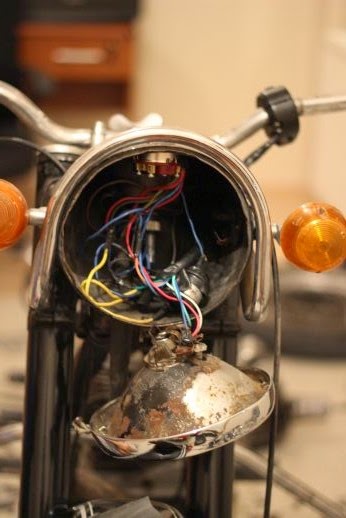Got some new toys recently. This means, now I am able to get some idea about the health of the engine. The simplest way to do that is by using the so called "engine compression tester", which I bought on the internet, instead of having a 15 minute ride just because of laziness - once again. Don't be fooled by the fancy name - it's just a pressure gauge, connected to a high pressure hose and a tight connection with an o-ring.
Let's remember how an engine works. There is a cylinder bored inside that big metal chunk, and a piston inside that, running up and down like crazy. As the piston goes down, the air-fuel mixture coming from the carb fills in the volume - so called "combustion chamber". Then, the piston moves upwards to compress the mixture in the combustion chamber. When it reaches the top, the spark plug ignites the now pressurized mixture and that energy pushes the piston downwards again. Lastly, the piston goes up to dispose of the exhaust gases of the combustion. And it goes on and on and on until you're out of gas... I think you can find this explanation in any driving license exam preparation material.
We're concerned more with the part of the cycle that we compressed the air-fuel mixture. Now we can get rid of the license exam preparations and find a high school chemistry book. You must be able to find the formula "PV=nRT" somewhere. In plain English, it says, if the amount of gas and the temperature is not changing, reducing the volume will end up increasing the pressure at the same rate. That sounds a lot like inside our cylinder.
The engines have a parameter called "compression ratio", meaning, how much the piston compresses the combustion chamber during the upward movement. Roughly speaking, a high compression ratio means a high power generation. This value is around 10:1 in modern gasoline cars and around 12:1 for the bikes. On the other hand, my poor old beemer has a compression ratio of 7:1. That is, the piston squeezes the inside volume to one seventh of it, consequently, the pressure will increase to seven times of the initial pressure, which was 1 Atmosphere. (About 15 psi). So what I am looking for is that the inside pressure should be somewhere near 7 Atmosphere.
Okay, now you can dump the chemistry book in a nearby trash bin.
 I removed the spark plug, and connected the end of the tester into the spark plug hole. It's a simple procedure, I'll kick start the engine a few times, of course without gas and spark, and check the pressure. If everything is intact and the combustion chamber is well isolated, I should see a value somewhere near 105 psi. Otherwise, it means that there is a leak somewhere in the system, and the engine performance is reduced accordingly.
I removed the spark plug, and connected the end of the tester into the spark plug hole. It's a simple procedure, I'll kick start the engine a few times, of course without gas and spark, and check the pressure. If everything is intact and the combustion chamber is well isolated, I should see a value somewhere near 105 psi. Otherwise, it means that there is a leak somewhere in the system, and the engine performance is reduced accordingly.
Big disappointment. I hardly got up to 55 psi. I was even able to hear a leakage somewhere around the cylinder head. But then where is the problem?
Basically there are two points that the combustion chamber can leak. First, the metal seals around the piston and second, the engine head cover, the gasket and valves over there. Now we know that the cylinder is leaking, in the second step, we try to eliminate the latter possibility.
I then remove the tester from the spark hole and put a little bit of motor oil inside. Thus, the oil will stick on the cylinder wall and form an isolation layer. So if the problem is with the piston seals, this additional layer should improve the isolation and we should see a higher pressure in our second measurement. But I don't like what I already heard in the first test at all. Not so optimistic for the second run.
As I guessed, the second measurement remains the same as the first one. This means that I should have a thorough look into the cylinder head cover and the valves when I open the engine up. The gasket is not an issue, it will be replaced anyway, but if it's the valves or the cover itself, than that means trouble.
















































